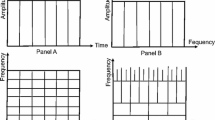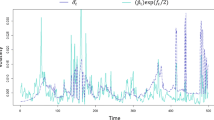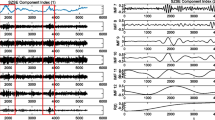Abstract
High-frequency data is a big data in finance in which a large amount of intra-day transactions arriving irregularly in financial markets are recorded. Given the high frequency and irregularity, such data require efficient tools to filter out the noise (i.e. jumps) arising from the anomaly, irregularity, and heterogeneity of financial markets. In this article, we use a recurrently adaptive separation algorithm, which is based on the maximal overlap discrete wavelet transform (MODWT) and that can effectively: (1) identify the time-variant jumps, (2) extract the time-consistent patterns from the noise (jumps), and (3) denoise the marginal perturbations. In addition, the proposed algorithm enables reinforcement learning to optimize a multiple-criteria decision or convex programming when reconstructing the wavelet-denoised data. Using simulated data, we show the proposed approach can perform efficiently in comparison with other conventional methods documented in the literature. We also apply our method in an empirical study by using high-frequency data from the US stock market and confirm that the proposed method can significantly improve the accuracy of predictive analytics models for financial market returns.




Similar content being viewed by others
References
Aït-Sahalia, Y., & Jacod, J. (2010). Is Brownian motion necessary to model high-frequency data? The Annals of Statistics, 38(5), 3093–3128.
Andersen, T. G., Fusari, N. & Todorov, V. (2017). The pricing of short-term market risk: Evidence from weekly options. Technical report.
Barndorff-Nielsen, O. E., & Shephard, N. (2006). Econometrics of testing for jumps in financial economics using bipower variation. Journal of Financial Econometrics, 4(1), 1–30.
Birgé, L., & Massart, P. (1998). Minimum contrast estimators on sieves: Exponential bounds and rates of convergence. Bernoulli, 4(3), 329–375.
Bollerslev, T., Todorov, V., & Xu, L. (2015). Tail risk premia and return predictability. Journal of Financial Economics, 118(1), 113–134.
Cai, T., & Silverman, B. (2001). Incorporating information on neighboring coefficients into wavelet estimation. Sankhya: The Indian Journal of Statistics, 63, 127–148.
Chen, Y.-T., Sun, E., & Yu, M.-T. (2015). Improving model performance with the integrated wavelet denoising method. Studies in Nonlinear Dynamics and Econometrics, 19(4), 445–467.
Chen, Y.-T., Sun, E., & Yu, M.-T. (2018). Risk assessment with wavelet feature engineering for high-frequency portfolio trading. Computational Economics, 52(2), 653–684.
Christensen, K., Oomen, R. C., & Podolskij, M. (2014). Fact or friction: Jumps at ultra high frequency. Journal of Financial Economics, 114(3), 576–599.
Cont, R., & Tankov, P. (2003). Financial modelling with jump processes (Vol. 2). Boca Raton, FL: CRC Press.
Donoho, D. (1994). Asymptotic minimax risk for sup-norm loss: Solution via optimal recovery. Probability Theory and Related Fields, 99, 145–170.
Donoho, D., & Johnstone, I. (1994). Ideal spatial adaptation by wavelet shrinkage. Biometrika, 81, 425–455.
Donoho, D., & Johnstone, I. (1995). Adapting to unknown smoothness via wavelet shrinkage. Journal of the American Statistical Association, 90(432), 1200–1224.
Donoho, D. & Johnstone, I. (1998). Minimax estimation via wavelet shrinkage. Annals of Statistics, 879–921.
Duffie, D., Pan, J., & Singleton, K. (2000). Transform analysis and asset pricing for affine jump-diffusions. Econometrica, 68(6), 1343–1376.
Engel, Y., Mannor, S. & Meir, R. (2015). Reinforcement learning with Gaussian processes. In Proceedings of the 22 international conference on machine learning, pp. 201–208.
Föllmer, H., & Schied, A. (2002). Convex measures of risk and trading constraints. Finance and Stochastics, 6(4), 429–447.
Ftiti, Z., Tiwari, A., Belanés, A., & Guesmi, K. (2015). Tests of financial market contagion: Evolutionary cospectral analysis versus wavelet analysis. Computational Economics, 46(4), 575–611.
Gençay, R., Selçuk, F., & Whitcher, B. (2002). An introduction to wavelets and other filtering methods in finance and economics. San Diego, CA: Academic Press.
Grubbs, F. (1969). Procedures for detecting outlying observations in samples. Technometrics, 11, 1–21.
Habimana, O. (2017). Wavelet multiresolution analysis of the liquidity effect and monetary neutrality. Computational Economics. https://doi.org/10.1007/s10614-017-9725-1.
Han, L., & Ge, R. (2017). Wavelets analysis on structural model for default prediction. Computational Economics, 50(1), 111–140.
Jacod, J., & Shiryaev, A. (2013). Limit theorems for stochastic processes (Vol. 288). Berlin: Springer.
Jiang, G. J., & Oomen, R. C. (2006). Estimating latent variables and jump diffusion models using high-frequency data. Journal of Financial Econometrics, 5(1), 1–30.
Jing, B.-Y., Kong, X.-B., & Liu, Z. (2012). Modeling high-frequency financial data by pure jump processes. The Annals of Statistics, 40(2), 759–784.
Lee, S., & Mykland, P. (2008). Jumps in financial markets: A new nonparametric test and jump dynamics. Review of Financial Studies, 21(6), 2535–2563.
Lee, S. S., & Mykland, P. A. (2007). Jumps in financial markets: A new nonparametric test and jump dynamics. The Review of Financial Studies, 21(6), 2535–2563.
Mancini, C. (2009). Non-parametric threshold estimation for models with stochastic diffusion coefficient and jumps. Scandinavian Journal of Statistics, 36(2), 270–296.
Marsalek, R., Pomenkova, J., & Kapounek, S. (2014). A wavelet-based approach to filter out symmetric macroeconomic shocks. Computational Economics, 44(4), 477–488.
Meinl, T., & Sun, E. (2012). A nonlinear filtering algorithm based on wavelet transforms for high-frequency financial data analysis. Studies in Nonlinear Dynamics and Econometrics, 16(3), 1–24.
Olayeni, O. (2016). Causality in continuous wavelet transform without spectral matrix factorization: Theory and application. Computational Economics, 47(3), 321–340.
Pennanen, T. (2011). Arbitrage and deflators in illiquid markets. Finance and Stochastics, 15(1), 57–83.
Percival, D., & Walden, A. (2006). Wavelet methods for time series analysis. Cambridge: Cambridge University Press.
Saâdaoui, F. (2013). The price and trading volume dynamics relationship in the EEX power market: A wavelet modeling. Computational Economics, 42(1), 47–69.
Sun, E., Chen, Y., & Yu, M. (2015). Generalized optimal wavelet decomposing algorithm for big financial data. International Journal of Production Economics, 165, 194–214.
Sun, E., Kruse, T., & Yu, M. (2014). High frequency trading, liquidity, and execution cost. Annals of Operations Research, 223, 403–432.
Sun, E., & Meinl, T. (2012). A new wavelet-based denoising algorithm for high-frequency financial data mining. European Journal of Operational Research, 217, 589–599.
Sun, W., Rachev, S., & Fabozzi, F. (2007). Fractals or I.I.D.: Evidence of long-range dependence and heavy tailedness from modeling German equity market returns. Journal of Economics and Business, 59, 575–595.
Todorov, V. (2009). Estimation of continuous-time stochastic volatility models with jumps using high-frequency data. Journal of Econometrics, 148(2), 131–148.
Todorov, V., Tauchen, G., & Grynkiv, I. (2014). Volatility activity: Specification and estimation. Journal of Econometrics, 178, 180–193.
Wiering, M. & van Otterlo, M. (Eds.) (2012). Reinforcement learning: State-of-the-art. Springer.
Xue, Y., Gençay, R., & Fagan, S. (2014). Jump detection with wavelets for high-frequency financial time series. Quantitative Finance, 14(8), 1427–1444.
Zhang, L., Mykland, P. A., & Aït-Sahalia, Y. (2005). A tale of two time scales: Determining integrated volatility with noisy high-frequency data. Journal of the American Statistical Association, 100(472), 1394–1411.
Acknowledgements
The authors thank the journal editor and two anonymous reviewers for providing valuable comments. Some of this work was previously described at the conferences of the Asia-Pacific Association of Derivatives and the Institute for Operations Research and the Management Sciences (INFORMS). The authors thank the participants of these conferences for their valuable and insightful comments.
Author information
Authors and Affiliations
Corresponding author
Additional information
Publisher's Note
Springer Nature remains neutral with regard to jurisdictional claims in published maps and institutional affiliations.
This work was supported by the InfoTech research project funded under USt-IdNr. DE320245686 and DAAD (Grant No. ST34-AP).
Rights and permissions
About this article
Cite this article
Chen, YT., Lai, WN. & Sun, E.W. Jump Detection and Noise Separation by a Singular Wavelet Method for Predictive Analytics of High-Frequency Data. Comput Econ 54, 809–844 (2019). https://doi.org/10.1007/s10614-019-09881-3
Accepted:
Published:
Issue Date:
DOI: https://doi.org/10.1007/s10614-019-09881-3




